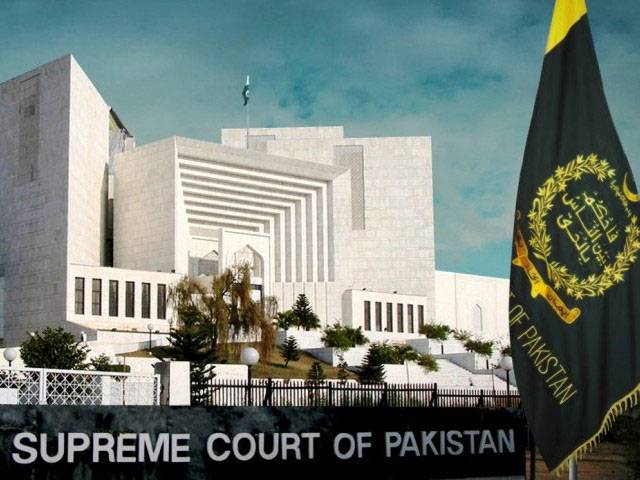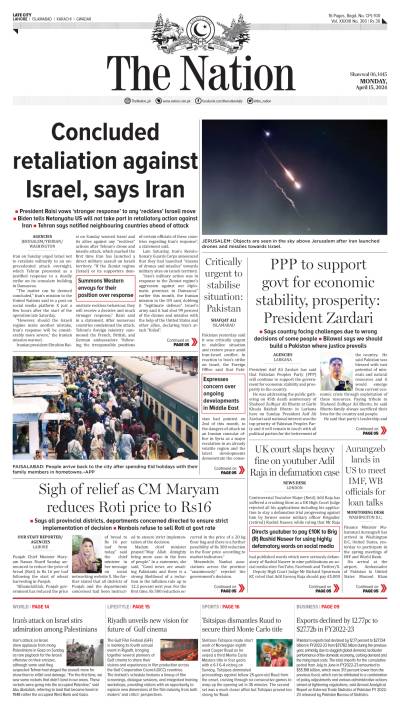ISLAMABAD - Rejecting an appeal against the Lahore High Court’s October 27, 2009, decision of dismissing a petition against US drone attacks, the Supreme Court on Wednesday declared that interference by the courts in such matters would be violation of the fundamental principle of the Constitution which envisaged trichotomy of powers among legislature, executive and judiciary.
A two-member bench comprising Justice Tasadduq Hussain Jilani and Justice Amir Hani Muslim, dismissing the appeal against the LHC order, ruled that the issue raised in the constitutional petition of Wukala Mahaz was related to foreign policy, defence and security of the country.
“Such issues do not fall within the judicial domain for interference under Article 199 of the Constitution of Islamic Republic of Pakistan,” said the two-page order of the apex court.
In an appeal against the LHC decision, Wukala Mahaz Barai Tahaffuz-e-Dastoor, through Sarfraz Ahmed Gorsi, had prayed to the court to direct the respondent (federation) to command the armed forces of Pakistan to defend the country against the US drone attacks. The court held: “Any such interference by the courts would be violation of one of the basic principles of the Constitution which envisaged trichotomy of powers among the legislature, executive and judiciary. We do not find the order of the learned high court to be exceptionable. The petition lacking merit is accordingly dismissed and leave refused.”
Wukala Mahaz Barai Tahaffuz--Dastoor had filed an appeal in the Supreme Court, challenging the decision of the Lahore High Court.
“If nuclear weapons are found to be incapable of protecting Pakistan and, instead, pose a threat to its survival, the respondent (federation) may be directed either to sell them in the international market to the highest bidder or place it in the safe custody of Iran,” the petitioner had pleaded.
The LHC’s division bench, headed by Justice Mian Saqib Nisar, while rejecting the petition, had observed in its order that it was a policy matter in which the court could not interfere, adding it was up to the federal government to take a decision in this regard.
The high court had observed that a court could not declare the US an enemy state because it was the responsibility of Parliament and the government to decide to wage a war against that country.
“Pakistani and Indian armies exchange fire very often in different sectors and sometimes casualties also occur, but on the basis of such incidents the courts cannot issue an order to wage a war against India,” the court had observed. The court had also observed that it had yet to be seen whether Pakistan was capable of hitting drones and how far its missile system could target accurately.
Qaeda seeking ways to target drones
Special Correspondent from Washington adds: Al-Qaeda’s leadership has reportedly set up cells of engineers to find ways to destroy and sabotage unmanned aircraft in an effort to curb the deadly US drone campaign against militants in the Middle East and North Africa that have also killed hundreds of civilians in Pakistan, Afghanistan, Yemen, Somalia and other places.
US intelligence officials have tracked the group’s efforts to create a counter-drone strategy since 2010, according to secret intelligence documents obtained by the Washington Post from National Security Agency leaker Edward Snowden.
The classified report, titled “Threats to Unmanned Aerial Vehicles,” consists of a summary of dozens of intelligence assessments posted by American spy agencies since 2006, The Post reported.
“Al-Qaeda Engineers in Pakistan Continue Development of Laser-Warning Systems in Effort To Counter UAV Strikes,” read the headline of one report in 2011, using the military acronym for unmanned aerial vehicles.
Beyond the threat that al-Qaeda might figure out how to hack or shoot down a drone, however, U.S. spy agencies worried that their drone campaign was becoming increasingly vulnerable to public opposition.
Intelligence analysts took careful note of al-Qaeda’s efforts to portray drone strikes as cowardly or immoral, beginning in January 2011 with a report titled “Al-Qaeda Explores Manipulating Public Opinion to Curb CT Pressure.” In July 2010, a US spy agency intercepted electronic communications suggesting that senior Al Qaeda leaders had distributed guides to its operatives around the world on how “to anticipate and defeat” drones, according to the documents.
The Defence Intelligence Agency, or DIA, concluded that Al Qaeda was sponsoring research projects to develop technology to interfere with infrared tags and GPS signals on unmanned aircraft, The Post reported, citing the secret documents.
Still, the documents show that American spy agencies have concluded that Al-Qaeda faces “substantial” challenges in its efforts to exploit the technological vulnerabilities of drones.
The Post reported that in 2011, the DIA reported that an “al-Qaeda-affiliated research and development cell currently lacks the technical knowledge to successfully integrate and deploy a counter-drone strike system.”
In Yemen, accelerated use of drone strikes under President Barack Obama and a US-backed offensive last year drove militants from territory they had seized a year earlier, during Yemen’s political turmoil amid the Arab Spring.
While the US acknowledges its drone programme in Yemen, it does not usually talk about individual strikes. The programme is run by the Pentagon’s Joint Special Operations Command and the CIA, with the military flying its drones out of Djibouti, and the CIA out of a base in Saudi Arabia.
Tuesday, April 16, 2024
Issue of drones beyond judicial review: SC

8:46 PM | April 15, 2024
8:44 PM | April 15, 2024
Meghan Markle demanding a grovelingly apology for the past
10:38 PM | April 15, 2024
Child Marriage Act: LHC terms difference in gender-based age criteria 'discriminatory'
10:37 PM | April 15, 2024
Elon Musk reveals 'crucial fact' about all-powerful Starship
10:35 PM | April 15, 2024
Aseefa Bhutto Zardari sworn in MNA
10:27 PM | April 15, 2024
Iranian President Raisi to visit Pakistan on April 22
10:26 PM | April 15, 2024
Policing Reforms
April 15, 2024
Storm Safety
April 15, 2024
Deterrence Restored
April 15, 2024
IMF Challenges
April 14, 2024
Security Crisis
April 14, 2024
Suicide awareness
April 15, 2024
Biden’s dilemma
April 15, 2024
Over dependence on technology
April 14, 2024
Education reform call
April 14, 2024
Brain drain
April 14, 2024
ePaper - Nawaiwaqt
Advertisement
Nawaiwaqt Group | Copyright © 2024





